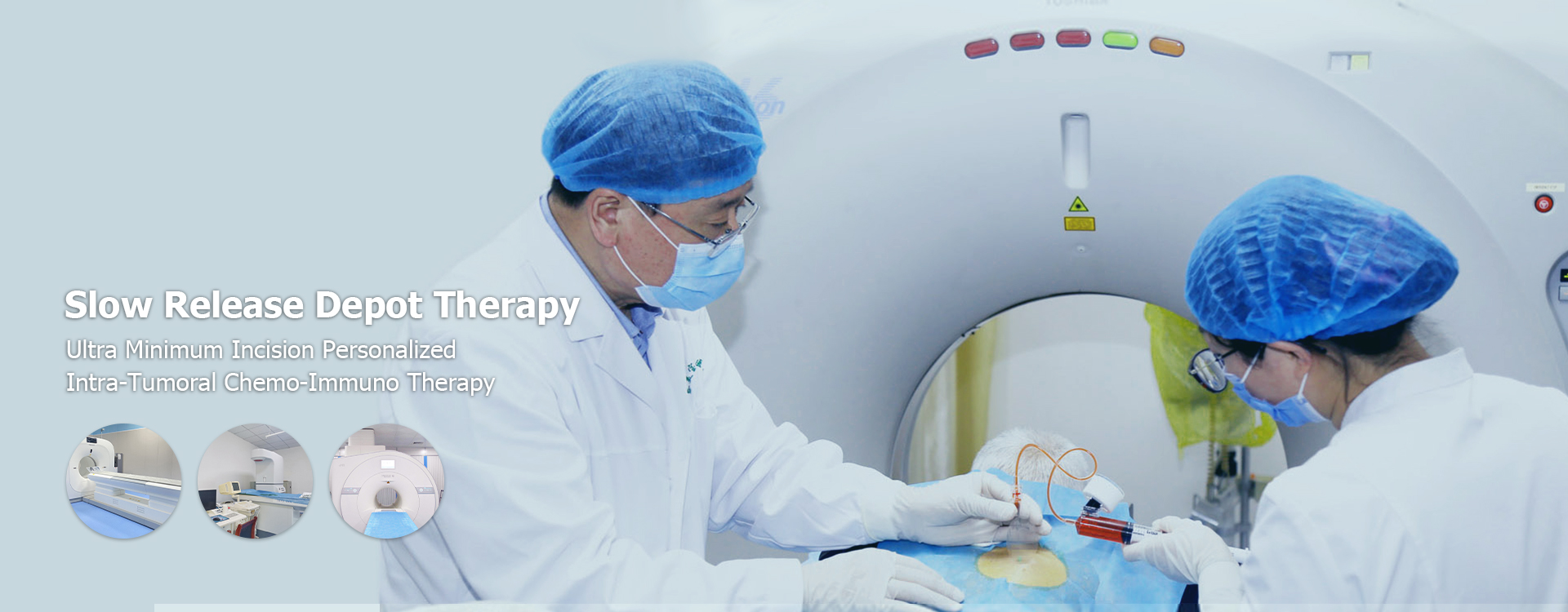
Slow Release Depot Therapy
Ultra Minimum Incision Personalized Intra-Tumoral Chemo-Immuno Therapy
The anti-cancer compound drug formed by the combination of sustained-release formulation, chemotherapy drug (dual drug), and immune adjuvant is directly injected into the tumor and embedded in the tumor under the guidance of CT, ultrasound, or endoscopy. The anti-cancer drug is gradually released within 7-20 days, killing cancer cells, avoiding the toxic side effects of the drug on the whole body and achieving the goal of eliminating the tumor; The self tumor antigens released by cancer cells killed by compound drugs at the same time, with the assistance of immune adjuvants, activate the systemic immune response of the body, thereby playing a role in clearing recurrent or metastatic cancer cells. Direct physical targeted targeted targeted killing and decapitation therapy can be performed for malignant tumors and metastatic lesions in various parts of the body, suitable for early, middle, and late stage solid tumors in all parts of the body. This therapy has obtained patented technologies in China, the United States, and Australia. Since its application in 1998, it has treated over 80000 cancer patients and achieved good treatment results!
Our major contribution is that sustained-release therapy integrates the advantages of chemotherapy and immunotherapy, and for the first time, the two have been combined and applied to intratumoral therapy through intervention. It integrates local and global treatment, and increases the concentration and time of drug action through sustained release of drugs within the tumor, which not only plays a local anticancer effect of chemotherapy drugs, but also takes into account the role of systemic immunotherapy, thus making up for the shortcomings of other therapies, providing new ideas and approaches for cancer treatment, especially for middle and advanced tumors, especially for reducing tumor recurrence and inhibiting tumor The transfer has very important value; UMPIC therapy has the advantage of using tumor as antigen source and autologous vaccine, which is also in line with the development trend of Personalized Medicine. And applied to the clinic, hapten combined with chemotherapy drugs for sustained release treatment of pancreatic cancer primary focus, while inducing distal effect, the essence of which is to induce immune response, T-cell-related CD4, CD8, DC, T and NK cells, and B-cell-related tumor autoantibodies: Antibodies to P53, P16, Cmyc, Zeta, IMP1, Koc, Survivin, p62, HCC1 and other oncogenes, this is the first time to find that T and B are involved in the immune response, and the clinical functions of the distal effect and this therapy was selected for "Clinical Operation Guidelines for Interventional Treatment of Advanced Pancreatic Cancer" (Trial) (7th edition) jointly formulated by the Chinese Anti-Cancer Association, the National Clinical Medical Research Center for Radiology and Therapy, and the National Interventional Medicine Innovation Alliance was published at
Journal of Clinical Radiology, volume 43, number 19, 2024, 1636-1648.

Dr.Baofa Yu and his team main interests research included as following:
1.Remote small tumors can be controlled, with evidence and articles;
2.The subclinical focus can be controlled, so the survival time of patients is long;
3.It also reduces circulating tumor cells (CTC) by 80%, article to be published;
4.It can stimulate the hypothalamus of the brain to participate in the immune response, and at the same time, it can also maintain the excitement of the brain with music to coordinate anti-cancer. The article has been completed, and UCSD professor suggests submitting it to nature or natural medicine.
UMIPIC-Therapy: Drug compound composition
Adjuvant: increasing immunological reaction and specific
Sustaining agent: holding all at high concentration for a long time
Antitumor agents: FDA approved regimes induced tumor death to release antigens from coagulation.

Six major advantages of Slow Release Depot Therapy: minimally invasive targeting, tumor decapitation, immune interception, multivalent vaccines, long-lasting, safe and effective.
Advantages at multiple leaves of interception tumor
(1) Tumoricidal Interception at primary site of tumor: under CT or ultrasound guiding, depending the size of tumor, you can inject suitable dose of compound solution.
(2) Sustaining of anticancer drug: oxidant induced coagulation in tumor to holding the drug for a long time and achieve better efficacy.
(3) Immunological interception: de-bulking main tumor meanwhile inducing immunological reaction to control micro lesion of tumor at secondary site of tumor.
(4) Autologous multiple tumor antigens : tumor associated antigens are the source for haptenation and vaccination: the real autologous antigen, the real multiple antigens and really personalized antigens.
(5) Simple to use : Can treat primary tumor also can treat secondary tumor too and can induce personalized immunotherapy.
(6) Safe and effective.





